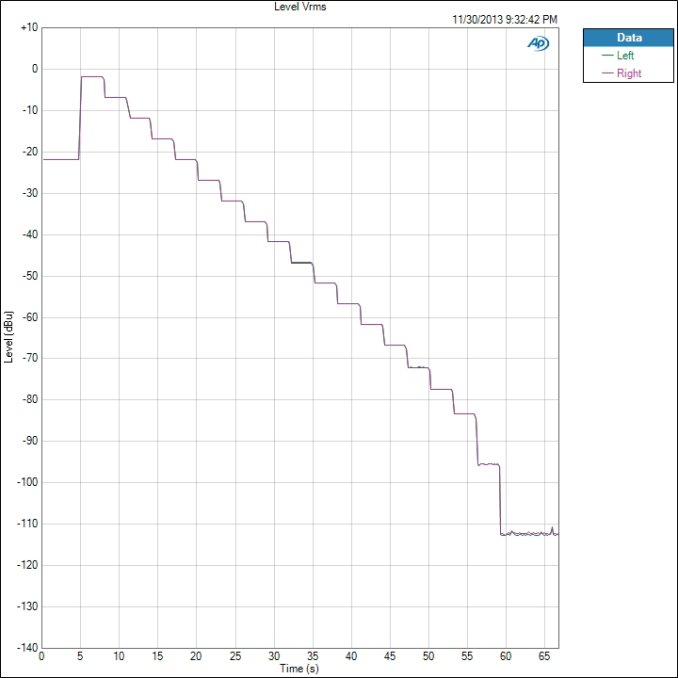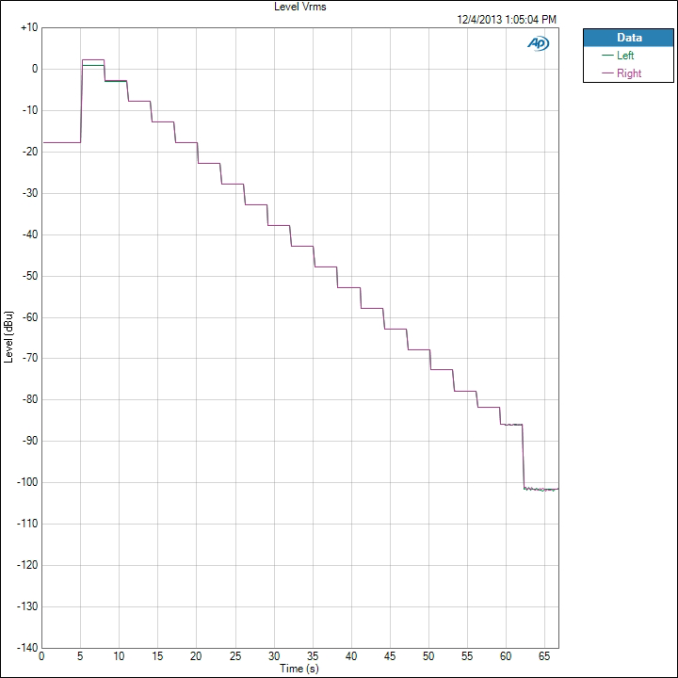Smartphone Audio Quality Testing
by Chris Heinonen on December 8, 2013 5:15 PM EST- Posted in
- Smartphones
- Audio
- Mobile
- Tablets
- Testing
Dynamic Range
The dynamic range of the phone indicates the difference between the loudest possible sound and the background noise. The more residual noise in the background, the lower the dynamic range. Phones with more powerful amplifier sections will typically produce a greater dynamic range. The residual noise level is often constant, so as the overall volume level increases the difference between the music and the noise increases as well.
The best performer here is the iPhone 5 again, with 92.214 dB of range. The worst is the Nexus 5 with only 89.332 dB. A difference of 3 dB is not something I would concern myself over. If we see a phone or tablet that drops down below 80 dB then I will start to show more concern.
Crosstalk
Crosstalk, like dynamic range, is just a number here. This is the measurement how much signal leaks from one channel into another. If an instrument should only be in the right ear, some of that signal will leak into the left ear, but we want that as low as possible. The results are expressed in -dB, or how much quieter one ear is than the intended ear.
On the Note 3 we see a wonderful crosstalk measurement of -117.2 dB so the sounds in one ear are -117 dB quieter in the other ear. This makes them impossible to hear. The worst is the iPhone 5, with only -75.624 dB of isolation.
Stepped Response
The stepped response uses a 1 kHz 0 dBFS tone but measures output level from maximum volume to minimum volume. We can see how large the volume steps are and how many there are. It doesn’t produce a number we can use, but it ties back into our other results. For a good example, we can look at the Note 3.
We see steps that are around -5 dBu each. The final level is muted and just the background noise of the device. Each step is clean and even but as we get lower and lower we see noise start to intrude. This is the background noise starting to become audible in the signal. The flatter the levels are, the quieter it will be. Now, let us look at the Nexus 5.
Notice at the very top how the right and left channels do not overlap. That is the clipping we talked about at the very beginning. It isn’t until the 4th volume setting that the level difference is down to nothing. Because of this, I would consider the top 3 volume settings of the Nexus 5 as ones that should be avoided. They each have enough THD+N introduced into them that it will sound poor, and one ear will be louder than the other.












188 Comments
View All Comments
lmcd - Sunday, December 8, 2013 - link
Only Anandtech :-)Curious to see how (badly) the S3 fares.
Old_Fogie_Late_Bloomer - Sunday, December 8, 2013 - link
Even with the occasional stinker of an article (yay, non-removable batteries...?), I have to say......it's stuff like this that keeps me coming back to the site. Only Anandtech, indeed. :) Keep up the quirky, in-depth work.
althaz - Sunday, December 8, 2013 - link
I don't know about the S3, but the S2 was rated very highly for audio quality.quick brown fox - Sunday, December 8, 2013 - link
I believe it was the opposite; S3 was lauded due to its wolfson dac (as well as the original Galaxy S), while S2 was condemned for not using that same DAC.Hopefully all gets measured so we can have some objectivity involved.
MadMan007 - Sunday, December 8, 2013 - link
Yeah but talking about a specific DAC chip is audio nerds looking at just a piece of the equation and using it as a potential red herring. The analog amplifiers and output, and overall implementation, matter much more than which specific DAC chip is used as long as it's not garbage, meaning basically any modern DAC chip.krazyfrog - Monday, December 9, 2013 - link
AnandTech actually tested the audio of the international Galaxy S II in their review and found it to be quite poor.zShowtimez - Monday, December 9, 2013 - link
After just moving from a S2 to a HTC One, let me tell you how awful the S2 was...Samus - Monday, December 9, 2013 - link
The surface(s) all use a wolfson dac and sound fantastic, too. The implementation means nothing if your base source is some realtek crap.Hemlocke - Sunday, December 8, 2013 - link
The i9100 had the Wolfson DAC, but the U.S. Variants didn't.onslaught86 - Sunday, December 8, 2013 - link
The i9100 did not have a Wolfson DAC. The i9300 did, while its US variants did not. And boy was it night & day coming from the i9100.